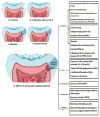Effect of biomaterials on angiogenesis during vital pulp therapy
- PMID: 27546854
- PMCID: PMC5209786
- DOI: 10.4012/dmj.2015-332
Effect of biomaterials on angiogenesis during vital pulp therapy
Abstract
This review intended to provide an overview of the effects of dental materials, used in dentin-pulp complex and dental pulp regeneration, on angiogenesis processes during regenerative endodontic procedures. An electronic search was performed in PubMed and MEDLINE databases via OVID using the keywords mentioned in the PubMed and MeSH headings for English language published articles from January 2005-April 2014 that evaluated the angiogenic properties of different dental materials used in regenerative endodontic procedures. Of the articles identified in an initial search, only 40 articles met the inclusion criteria set for this review. Vital pulp therapy materials might have positive effects on angiogenesis events, while most of the canal irrigating solutions and antibiotic pastes have anti-angiogenic activity except for EDTA. Future clinical studies will be helpful in defining the mechanisms of action for dental materials that promote or inhibit angiogenesis events at applied areas.
Figures



References
-
- Saghiri MA, Orangi J, Asatourian A, Sheibani N. Functional role of inorganic trace elements in angiogenesis Part II:(Cr, Si, Zn, Cu, and S) Crit Rev Oncol Hematol. 2015;96:143–155. - PubMed
-
- Saghiri MA, Asgar K, Lotfi M, Garcia-Godoy F. Nanomodification of mineral trioxide aggregate for enhanced physiochemical properties. Int Endod J. 2012;45:979–988. - PubMed
-
- Saghiri MA, Lotfi M, Aghili H. Dental cement composition. 8, 668, 770. US Patent. 2014
-
- Saghiri MA, Lotfi M, Saghiri AM, Vosoughhosseini S, Fatemi A, Shiezadeh V, Ranjkesh B. Effect of pH on sealing ability of white mineral trioxide aggregate as a root-end filling material. J Endod. 2008;34:1226–1229. - PubMed
Publication types
MeSH terms
Substances
Grants and funding
LinkOut - more resources
Full Text Sources
Other Literature Sources
Miscellaneous

